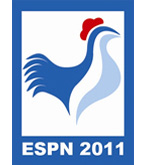Second day has two faces at ESPN2011

Subjects on nutrigenomics or feeding the genes in the morning and topics on the value of feed processing in the afternoon gave the second day at the European Symposium on Poultry Nutrion in Cemse, Turkey two different faces.
Nutrigenomics and epigenetics in poultry were addressed by Chris Ashwell, Associate Professor of Animal Genomics of the Department of Poultry Science, North Carolina State University, USA.
The old axiom of you are what you eat is rapidly being replaced by the new phrase you are what your mother ate , due to the advent of new technologies and the quest for knowledge of the molecular basis of biological processes.
Recent technologies have led to the new field of functional genomics (how the genome of an organism regulates homeostasis and responds to its environment).
They take nutrition to a molecular level. Practical implications are still far away as this technology is for now mainly a laboratory exercise.
Turning genes on and off
Nutrigenomics were further discussed by Michel Duclos of INRA in France who discussed “Combining functional and positional genomics for understanding nutrient gene interactions”.
With the use of appropriate models this strategy should permit the identification of alleles controlling the use of nutrients, or how to use nutrients to turn genes on and off.
With such results, innovations in selection and nutrition will combine in new strategies for sustainable poultry production schemes.
Sophie Tesseraud, also of INRA in France, further elaborated on amino acid nutrition and gene expression in poultry.
Studies conducted over the last ten years indicate that amino acids are involved in the control of gene expression. In particular, amino acids alone or together with insulin are able to regulate the expression of genes related to protein and energy metabolism via different signaling pathways.
Until now these subjects remain feed for specialists.
Value of feed processing
Closer to practice was the subject of Manfred Peisker of ADM Specialty Ingredients, the Netherlands, who talked about how feed processing impacts on nutritive value and hygienic status of poultry feeds.
The old paradigm of grinding as fine as possible and as coarse as needed to enhance nutrition has been turned around. Today poultry feeds ought to be ground as coarse as possible and as fine as unavoidable.
The reason behind this is that coarse feeds enhance gizzard function and decrease pH in the GI-tract which makes it difficult for salmonellas to establish in the gut.
Pelleting does not help digestion
Starch is the most abundant nutrient in broiler diets. During pelleting, a small part of the starch will gelatinise, but this may neither contribute to increased starch digestibility nor improved pellet durability.
Birger Svihus, of the Department of Animal and Aquacultural Sciences, Norwegian University of Life Sciences, Aas, Norway further elaborated on the interaction between starch, pelleting and broiler performance.
It has been shown that starch digestibility may be reduced when pelleted diets with a high amount of starch, particularly from wheat, is fed to broiler chickens.
He concluded that this may be due to feed overconsumption in a situation where the diet contains few structural components to stimulate gizzard development.
Making better pellets
Joseph Moritz of the Division of Animal and Nutritional Sciences, West Virginia University, Morgantown, USA tried to prove the positive effect of making good quality pellets.
Pellet quality produced from integrated poultry operations in the US is often poor, mainly caused by feed volume requirements and lack of data associated with economic implications of high quality pellet production and feeding.
Recent research has demonstrated economic benefits of feeding high quality pellets to broilers that were based on diet cost, feed intake, and subsequent gains in carcass weight.
These benefits were associated with several feed form attributes and not changes in nutrient availability.
If a poultry company were to pursue these economic benefits linked to feeding high quality pellets, then any of a number of feed manufacture strategies may be implemented.
Moritz concludes that decreased nutrient availability due to pelleting may in part increase perceived nutrient requirements of poultry fed pellets.
An appreciation of the relationship between feed manufacture strategies, pellet quality, and nutrient availability may aid in increasing overall profitability of poultry production.











